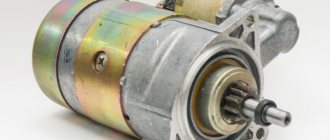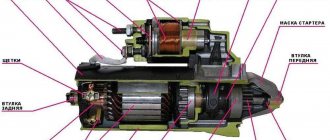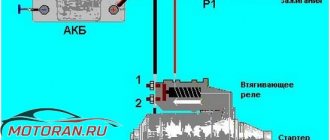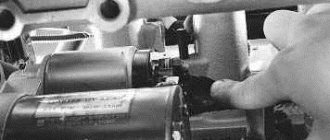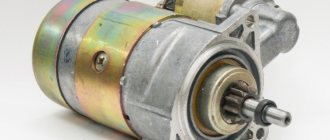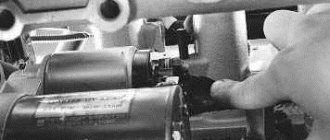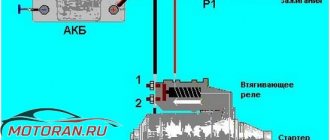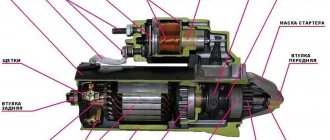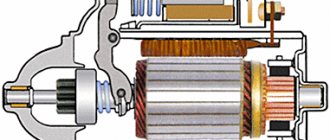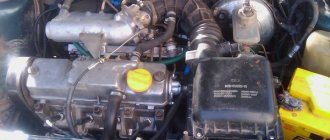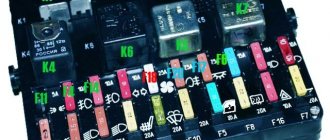Hello, dear car enthusiasts! Many of us, motorists, have at least once in our lives found ourselves in a situation where the car starter stubbornly refused to fulfill its intended purpose.
According to the well-known Murphy’s law (in common parlance “the law of the falling sandwich”), such troubles happen at the most inopportune moment - you have to go, and time is running out. In such cases, there is nothing left to do but start the car without a starter or close it directly and hit the road.
Before closing the starter directly, diagnostics are recommended
Before taking decisive action, it would be a good idea to try to identify the causes of starter failure, because some of them can be eliminated on the spot.
The most difficult starter failures include:
- starter relay fault
- Solenoid relay malfunction
- Bendix wear
- burnt out starter winding.
If you have diagnosed one of these complex breakdowns, you can immediately begin to look for a way to start the engine with a non-working starter. These methods are few, but they work flawlessly.
The essence of the first simple and reliable way to start a car without a starter is that several strong, sympathetic neighbors in the garage rest their hands on the trunk of the car and, on command, begin to accelerate.
While you are driving, you turn on the ignition key and first gear. The more active the pushers are (in terms of acceleration speed), the faster the engine will start. This method of starting a car is called “push-start” and is the most popular among car enthusiasts.
The second most popular and effective auto-folk method to “revive” a car engine is towing. It consists in the fact that your car is towed by another car for some distance using a cable.
You need to exercise maximum caution in this case: first, keep in mind that when your car starts, it will definitely begin to accelerate. Secondly, when the car in front of you stops, do not forget to stop your car. Finally, do not turn off the engine when you get out of the car to unhook the cable, otherwise you will have to repeat the entire procedure.
How to start a car without a pushrod and a cable? Just close the starter.
You can try to bring the car back to life without using brute physical force. To quickly complete the task, you need to have an idea of how to close the starter directly.
Let's figure out how to start the starter directly or, in auto-folk language: how to close the starter with a screwdriver, wrench, pry bar or other suitable means at hand.
It is worth mentioning right away that a screwdriver and a wrench will only help if the cause of unsatisfactory operation of the starter is a malfunction of the solenoid relay.
How to start the starter directly?
A starter is an electric motor designed to convert electrical energy into mechanical energy. In a car, this effect is used for ignition, because the internal combustion engine unit is not able to start instantly - its parts and mechanisms must first be set in motion. That is, the starter provides primary rotation of the crankshaft.
To fully understand the concept of direct starting of a starter, it is important to understand how its design works, which consists of 5 main elements:
- cylindrical metal body;
- anchor - steel axis;
- a solenoid relay that transfers electrical energy from the ignition switch to the starter motor;
- Bendix (or overrunning clutch) is a roller mechanism that rotates the flywheel crown through the drive gear;
- brush holders and brushes that supply voltage to the armature.
Most starters, with minor differences, are structurally identical to each other.
Principle of operation
The process begins with turning the key in the ignition, which provokes the movement of electricity to the traction relay from the battery. The Bendix then engages the flywheel via a drive gear. Along the way, the circuit is closed and power is transferred to the engine, which leads to the movement of the crankshaft. As soon as the shaft rotation speed begins to exceed the starter speed, the bendix will disengage. And the key returns to its standard position.
Starting the starter directly: when will it help and how to do it?
If, when you turn the key, you hear a characteristic click under the hood and the unit does not start, this indicates a malfunction of the traction relay. It is in such situations that it is recommended to start the starter mechanism directly. In other cases, this solution will not help.
IMPORTANT! When starting the starter directly, the coil may burn out. Therefore, attempts to start the car in this way should be extremely careful. If two or three attempts did not lead to the engine starting, then it is better to abandon the idea altogether. This way, at least the likelihood of damage will be minimized.
Before starting, be sure (!) to set the gear to neutral and apply the parking brake. When you are done with the preliminary preparation, close the power terminals on the starter with a screwdriver with an insulated handle (it will work as a traction relay) and turn the ignition key. Since it is difficult to cope with this procedure alone, you will have to call an assistant - one person closes the circuit, the other turns on the ignition.
Note! The location of the starter varies depending on the car model, but the range of possible locations is fixed. The unit is always located at the junction of the engine and gearbox, next to the bell-shaped casing. In some cars, access to the starter is through the engine compartment, that is, the unit is located closer to the top. In other cases, the starter is accessible from under the bottom, as it is located closer to the bottom.
Alternative ways to start the starter mechanism
Closing with a screwdriver is not the only method that exists to start a starter. If it does not work and there is no clicking noise from under the hood, then you can use the following short circuit options:
- “From the pusher” is the classic and most popular solution in such a situation. It is implemented with outside help, when one or more people push the car from behind, and the driver tries to start it in first gear. The more powerful the push, the faster the car will start. Effective in cases of breakdown of the relay or starter winding.
- Towing - the principle is the same as in the previous case, only now instead of human power, a tow rope attached to another vehicle is used. The leading car should move off smoothly and slowly pick up speed. The “followed” vehicle must follow the lead and not brake or accelerate individually. It is important for the driver in tow to remember this, including when the car starts, because as soon as this happens, the car will begin to accelerate. In this case, you cannot immediately turn off the engine in order to unhook the car from the cable, otherwise you will have to repeat the procedure again.
It is worth noting that owners of cars with automatic transmission have a very limited choice of methods for starting the starter, since towing is contraindicated for them due to the design features of the vehicles.
Replacing the unit
Now another question arises - how to disassemble it? There shouldn’t be any particular problems with this matter if you arm yourself with the instruction manual and also read our recommendations.
Arm yourself with a set of keys for 10, 13, 15 and 8 millimeters. Actually, you don’t really need anything else in terms of tools.
Replacement
The sequence of dismantling and repair is as follows:
Drive the car into the pit or lift it using a lift. You must have access to the underside of the car. If you have just arrived, give the engine some time to cool down. It is better to work with a cold engine. Remove the negative cables from the battery. First remove the protection and then the tin casing that protects your gearbox. To do this, you will need two keys - 8 and 10 millimeters. The power wire plug is removed from the starter. You just need to pull it towards yourself a little. Now take a 13 mm wrench and use it to unscrew the power wiring located on the solenoid relay. Place the loose wire aside and secure it with something temporarily so that it does not interfere with further repairs. The starter is attached to the gearbox housing with two nuts. They are easily loosened with a 15mm wrench. If you have problems unwinding, lubricate the fasteners with the almighty WD40. Dismantle. Now check the condition of the bushings on the gearbox housing. Make sure that the armature shaft is in good condition; when moving, there should be no play or jamming. If such defects occur, then it is recommended to immediately replace the bushings with new and high-quality ones. There are always two bushings. One is at the bottom of the starter, and the second is on the gearbox housing. The bushing on the starter can be changed without any problems, but difficulties may arise with the second one. To dismantle it, you need a special tool called a rubber. It is better to entrust the work to specialists from a service station. If the cause of the starter malfunction is the bendix or the solenoid relay, there is no need to call the experts for help. To remove the relay, unscrew the power wire, or rather its fastening, from the starter housing. You will need a 13mm wrench. Use a 8mm wrench to remove the two bolts securing the relay to the starter housing
It is important to be careful here, because when removing the bolts, there is a spring in the relay that can spring back. Hold it with your hand when dismantling. Remove the relay piston from the rocker arm hook located on the bendix. Proceeding in reverse order, install a new relay. If you need to replace the bendix, then remove the solenoid relay, unscrew the two bolts with a 10mm wrench at the back of the starter
Now disconnect the starter housing from the front of the starter where the bendix, rotor and fork are located. Use a flathead screwdriver to pry up the plastic fork to remove it from the armature, and remove the armature itself and the bendix from the front of the body. Remove the retaining ring located on the tip of the armature and remove the desired bendix. The structure can be assembled in the reverse order, but the splines must first be lubricated with Litol. Test the new starter in place before beginning installation. To do this, connect the power terminals of the battery. The nuts responsible for fastening the terminals are tightened with a 13mm wrench. But it is not recommended to apply much force, since the terminals are made of copper. Clamping too hard will damage the threads, causing even more problems.
We figured out how to disassemble the starter on a VAZ 2110 and we can say that this procedure is not particularly simple, but it does not require mandatory execution by a professional auto mechanic.
The starter on the “ten” is somewhat capricious, but if you operate the car correctly, check the condition of the contacts, and also periodically flush the engine on the injection VAZ 2110, it can last a long time and reliably.
How would you rate the difficulty of the job?
- Easily
- Fine
- Difficult
View Results
Loading …
How to quickly close the starter with a screwdriver or other means
Many motorists have to deal with problems related to the vehicle starter at least once in their lives. The starter stubbornly refuses to work as before, although it itself is not damaged (the solenoid relay becomes the problem). We will look at what to do in this case and how to revive the starter in our article. There is Murphy’s law, known to all people on earth, as it is also popularly called the law of meanness. The car breaks down at the most inopportune moment, when you urgently need to go somewhere, and time is running out. In this case, there is nothing left to do but close the starter contacts in order to revive this important element of the car.
Battery connection
This method uses a copper cable, terminals and plug, with this you can connect the starter and battery of the car. If you connect all the parts, you will get a kind of carrier, and it will help start the engine. Then the car is at neutral speed and the ignition is turned on, the homemade carrier is connected to the positive on the battery. If everything is in order with the starter, then the engine will start easily, and then quickly remove the terminal and return the connection to its original place.
Diagnostics
It is necessary before the motorist wants to take active action. If you can identify the reasons for this behavior of the starter, then they can be eliminated right on the spot, without even going to a car service center and without wasting extra time. The basics of starter repair teach us that the most complex breakdowns are the following:
- The starter relay has failed;
- The solenoid relay has deteriorated;
- The bendix is worn out;
- The starter winding is burnt out.
If at least one of the above breakdowns is confirmed, you have to look for ways to start a car with a non-working starter. They exist, but they are very few. But they will help you cope with the problem 100 percent.
Other problems
The starter works and clicks, but the engine cannot start? The problem may be excess moisture under the hood. All you need to do is move the car to a place where there is no moisture and dry it. If the engine started, the problem was excess moisture. All that remains is to determine where the moisture came from and try to eliminate the problem.
It is likely that the on-board computer is generating an error. To fix the problem, it is important to conduct a full diagnosis and, if necessary, install new firmware. Then try to start the car again.
Finally, the problem may be in the crankshaft. The shaft itself may give incorrect signals about its position, and the on-board computer, in turn, will make incorrect fuel supply calculations. Result: the starter will rotate, with a characteristic clicking sound, but there will be no result.
So, the starter works and turns, but the car refuses to work and will not start. You can use the advice from the article, or don’t worry and contact a quality car service center.
Method two - towing
No less efficient and even more reliable, but you need another machine more powerful than your car. It will be enough to tow the vehicle for a short distance, and then start the engine in the same manner as described above. In this case, I would like to give a couple of practical tips:
- Do not turn off the car after it has started and then go straight to the service center;
- Do not forget that after starting the car, it will pick up speed if it is in second gear and you press the accelerator pedal;
- Don’t forget that after starting, the car towing you will stop. Therefore, you will need to have time to slow down.
Other reasons why the Lada Granta does not start
There are many possible breakdowns. To begin with, it’s a good idea to check the battery charge level, since you won’t be able to start without a battery. Also, make sure that the terminals on the battery are tight and have not oxidized. If the car is already three years old, then special attention should be paid to the issues of terminal oxidation.
Keep in mind that after prolonged cold weather, the charge level may drop to one third of its original volume. If necessary, the car can be covered with a special cover, which will save the accumulated heat for a long time.
Malfunctions may also affect the fuel system. Similar reasons are typical for situations when the car starts, but immediately after that it stalls. If so, then most likely the problem is a burnt out fuel pump.
And, of course, do not forget that the spark plugs may simply deteriorate. This happens after prolonged operation of the power unit at high speeds. To prevent them from burning out, you need to periodically clean their contacts, as well as maintain the normal operating parameters of the car.
Among other things, it would be a good idea to inspect the air filter. Before doing this, the air filter must be removed from the car. If it is too clogged, soot can accumulate in the cylinders, which will lead to certain problems in the operation of the machine.
The third method is closure
And finally, we come to the actual topic of this article: correctly closing the starter with a screwdriver. In this case, brute physical force or towing is not needed. It will be enough to arm yourself with a simple screwdriver, preferably with a long handle. Before moving directly to the process algorithm, let's dwell on the question: what is better to close the starter - with a screwdriver, wrench or pry bar? Let us note right away that a mount is an option for a rainy day when you don’t have a screwdriver or a key at hand. As a rule, a screwdriver and a wrench help in cases where the relay is faulty. The characteristic clicks coming from under the hood when turning the key in the ignition are full confirmation of this. The Bendix gear is not able to turn the crankshaft because the relay does not provide enough energy. It remains to close the starter, giving voltage directly to the windings. As mentioned above, it is advisable to arm yourself with a large screwdriver or wrench that would reach both power terminals of the relay in order to bridge them. Don’t forget to set the gearbox lever to idle and tighten the handbrake all the way. The key in the ignition switch must be turned half a turn so that the corresponding lights on the instrument panel come on. A screwdriver attached to the terminals in this case works like the relay itself. The method, as we see, is not tricky. But you must always be on your guard. The fact is that you can damage the coil. It easily fails if you do this several times in a row. It’s just that on classic contact systems the coil does not have the appropriate protection, as on non-contact systems. To protect the coil from burning out, it is recommended to do the following:
Closure
- Ask the assistant to get into the car;
- Have him put the ignition key in the ignition position while you close the contact.
Thus, having learned how to revive the starter yourself, you can safely go to the longest distances.
The problem will be solved in one minute. But then it will be necessary to visit a car repair shop, where the starter will undergo a thorough diagnosis by specialists. They will immediately determine the cause, eliminate it, and you will no longer fall under Murphy's Law. Although no one can guarantee that this will not happen after a certain period of time.
conclusions
Let's look at diagram 1 again. If the key is not turned to the Start label, terminal S is “hanging in the air.” This can be done for any car, even if the circuit has an additional relay. This means that it will not be necessary to disconnect the standard wire from terminal S... And in the case of a VAZ, the disconnection is carried out in order to gain access to the terminal.
This is interesting: Adapter for diagnosing VAZ cars
We removed the filter, disconnected the plug, and tried to close it...
If the engine filter cannot be removed or access is blocked by the battery, we do it differently - we use only the crank.
It is better to close the contacts not with a screwdriver, but with any wrench (see photo). It is desirable that the handle be insulated.
12 Volt voltage is not dangerous, but errors can result in blown fuses. Good luck.
For those who do not understand everything: the filter must be removed from the mounts, but not from the “corrugation”. The filter housing is placed on the battery.
How can I close the starter?
Starters in cars fail on average once every 5 years. And here the following trend is observed: in most European and American cars this part has to be replaced much less frequently than in products of the Russian automobile industry. In particular, even in a completely new VAZ car, the starter sometimes breaks down every 1.5-2 years.
If suddenly such a breakdown occurs in your car and the need arises to start it with a failed starter, you can do this even without having practically any tools at hand. To learn how to close the starter , watch the video. Add this page of our website to your browser bookmarks, and you can always quickly access it at any time you need.
If at the same time you are stuck somewhere in the wilderness or in the mountains, then perhaps you should contact the Ukrainian Emergency Service.
A little theory
In principle, everything is clear with the main question. The entire procedure for closing the starter is accessible and does not require special knowledge and practice. But most people may be wondering why the starter does not want to start the internal combustion engine?
The fact is that the solenoid relay has a solenoid, an electromagnetic coil and a contact group in its design. The latter, in turn, has a washer and two bolts (copper).
As soon as the driver turns the key, the solenoid extends the drive clutch and it comes into contact with the flywheel crown. Next, the solenoid closes the contacts in the relay cover. And through these contacts electricity reaches the winding.
This simple process powers a car engine. But when the above-mentioned contacts oxidize, current can no longer pass through them, which means that the necessary charge of electricity does not reach the winding, as a result of which the car does not start.
In this case, to start the internal combustion engine, you can use several proven methods, such as: closing the starter with a screwdriver, asking your garage or parking lot mates to push the car (start it with a pusher) or take it in tow.
Common starter failures
The main functions of this part are reduced to starting the internal combustion engine. A closed starter creates torque at the required number of revolutions, and this, in turn, allows the combustible mixture to compress and burn.
A typical starter consists of the following elements:
- brush assembly;
- electromagnetic retractor relay;
- bendix;
- planetary reductor;
- cover with plain bearing;
- housing assembly;
- rotor with commutator;
- brush assembly.
If the module does not function normally, carefully inspect the battery and the entire electrical circuit. Possible causes of the problem:
- the contacts are not secured well enough;
- battery is discharged;
- wiring damage;
- the oil in the crankcase does not meet the required viscosity grade;
- damage to the ignition switch.
Another common problem is a short to ground in the engine. Why does the starter close in this case? It's all about the bolts on which it is attached: they may not properly ground the electric motor due to a manufacturing defect or due to mechanical damage. To fix this, you need to replace the bolts with new ones.
If the starter does not turn on, then most likely the problem is a faulty relay or a short circuit in the winding. Cases when the armature rotates, but the starter cannot turn the crankshaft, are usually caused by slipping of the clutch or defects in the screw thread.
If your starter or other parts are broken, please note that the website ZAPCHASTI.RIA.COM contains about 1,000,000 of all kinds of spare parts. Here you can pick up any spare part for any car.
Checking and repairing the solenoid relay
Straight to the point. You try to start the car, but nothing works. At the same time, you are absolutely sure that the battery is charged and the electrical network is in order
In this case, you should pay attention to possible problems with the starter, as well as its auxiliary devices. And the first thing you should inspect is the solenoid relay
So let's do this.
Remember that the main principle of operation of the solenoid relay is based on magnetism! That is, when voltage is applied to the winding, the armature is attracted, and the armature pushes out the Bendix gear, which engages the “crown” of the flywheel. At this moment, contact occurs and energy flows to the starter winding. The main thing is that all these processes occur almost simultaneously, therefore, they directly depend on each other.
And it is precisely in the case when something is violated during these actions that a problem arises with starting the engine.
Possible reasons:
1) the winding on the relay or starter is burnt out;
2) inside the relay, the “nickels” on the contacts are partially or completely burned out (“nickels” are contact plates);
3) wear and tear or complete destruction of materials.
You can check the condition of the relay without even removing the starter. To do this, you need to close two contacts (bolts) on the back side with a piece of wire. This way, you will ensure that voltage is supplied directly to the starter winding (the current will bypass the solenoid relay winding).
And when you turn the key in the ignition switch and the car starts, the problem is detected: the coil of the solenoid relay has burned out. But if the car does not start in this case, then the problem lies directly in the starter and it is this that needs to be repaired.
But let’s say that the problem lies precisely in the solenoid relay. How to repair it?
Unfortunately, most car manufacturers are too zealous about the reliability of car components. In the sense that the solenoid relay can be absolutely integral, that is, not dismountable. In this case, you will need to completely replace the “dead” node.
It’s another matter if the solenoid relay can be disassembled. Then you can not only visually assess the scale of the problem, but also find a solution. For example, if burnt contacts are detected, they can be cleaned.
But if you don’t want to tinker on your own, then contact a car service.
In any case, you shouldn’t delay the repairs: it will cost more.
And one last thing. If you decide to repair the relay yourself, consider the following:
1) be sure to mark the terminals - which one comes from where;
2) immediately before installing the terminals in place, they must be cleaned and degreased. Do the same with contacts.
Kolodiychuk Andrey
, especially for
How to make the starter close while driving
If the starter does not start naturally, you can start the car using alternative methods. For example, when the problem is a faulty coil or relay, you can make the short circuit needed to start the engine by manually pushing the car. Of course, you can only do this yourself if the car is on a descent, but it’s not worth the risk. It’s better to just ask random passers-by for help, so that they put their hands on the trunk and try to move the vehicle forward while you turn the ignition key and engage first gear. The higher the speed the assistants give the car “from the pusher”, the easier it will be to start it.
An alternative method to pushing is towing. In order to carry it out, you will need a cable and another car. If an unexpected stop occurs on the road, try to stop one of the drivers passing by. Surely someone will not refuse to help. Towing should be done very carefully, because once your car starts, it will begin to accelerate. Immediately inform the driver helping you about this and gradually slow down. When you stop, do not turn off the engine.
Push launch
This is a classic way to start the engine on almost any car. It should be used when other methods are powerless. To do this you will need to do the following:
- Place the gear lever in neutral.
- The driver gets behind the wheel.
- Two assistants are pushing the car.
- Once the car has accelerated a little, engage first or second gear.
- Turn the key to engine start mode.
This method can be used while towing a car. But remember that when you start the engine, the car will accelerate significantly and may drive into the bumper of the towing car.
How to close the starter directly with a screwdriver
If the starter fails due to a problem with the solenoid relay, you can close it with a screwdriver to start the engine. It is not difficult to determine that the problem is in the relay: a clear sign of this is a clicking noise coming from under the hood when turning the key. A characteristic sound indicates that the relay is turned on, but the crankshaft does not rotate.
In order to successfully solve the problem, you must know which contacts to close on the starter with a screwdriver. You need to proceed as follows:
- Place the transmission lever in the neutral position.
- Apply the brake.
- Insert an insulated screwdriver between the power terminals.
- The tool temporarily takes over the function of a relay, and a short circuit occurs.
It is better to have someone assist you during this operation. Let one person insert the screwdriver, and the second person close the contacts.
What to do if there is no key
The method we just looked at is not the only way to start the starter.
There are several more options. The first involves starting the starter from inside the car. To do this, you will need to remove the plastic panel that is located under the steering wheel of the car. The next step is to separate the wiring harness going to the ignition switch.
Find the wire that goes to ground (could be black, green, or yellow with a black stripe). It is possible to determine the required conductor using a tester. Connect one tip to the wire being tested, and the other to the car body. If the display shows zero, then that's what we need.
Strip the neutral wire, insulate it and move it to the side. Power to the starter on the VAZ-2114 is supplied through a red or yellow wire. To avoid confusion, check with a tester.
Connect the remaining bundle to the positive wire, and then close it with the starter terminal. If you have determined everything correctly, the engine should start. Keep in mind that you cannot connect the wires for a long time, so as not to discharge the battery.
As with the first method, the gearbox must be in neutral.
We start the car without interfering with the engine compartment
If the car has a small mass, and there are assistants nearby and space that allows unhindered acceleration, then you should resort to the method popularly referred to as “push”. To do this, the driver needs to turn the ignition key, then, with sufficient acceleration of about 10-20 km, depress the clutch and engage second gear, then confidently, but slowly, depress the pedal, as soon as the car starts, it is recommended to engage neutral gear and allow the engine to warm up to operating temperature.
Please note that this method only works on cars with a manual transmission. In winter, it is recommended to start in third gear to avoid wheel slipping.
There is also a way for cases where there are no assistants or the necessary space for maneuver.
Important! Only suitable for vehicles with front wheel drive and a working handbrake.
We place a jack under one of the front wheels, after lifting, wrap a cable or any other similar rope around it and with a sharp movement try to turn the wheel in the direction of travel. Just remember to turn on the ignition and second gear first. If the engine starts successfully, put the car in neutral and lower the car; if the attempt fails, repeat the action.
It is worth mentioning the towing method; as a rule, car owners are always ready to help a fellow driver in a difficult situation, so do not hesitate to ask for help. The principle of operation is the same as with a pusher, just be careful when the car starts up not to hit the car towing you.
